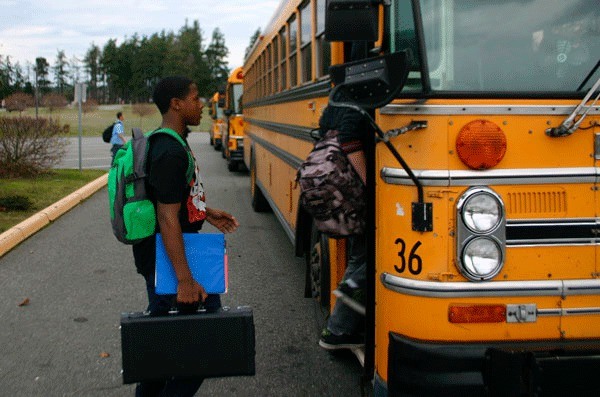With the approach of the 2013 levy next year, the Oak Harbor School District seeks input on what should be included.
The school board meeting includes a public forum Monday, Jan. 9 at 6:30 p.m. to address whether funding for transportation and food services should be included in the regular maintenance and operation levy.
Transportation has never been paid for by a levy, according to Superintendent Rick Schulte. The state funds approximately $1.3 million, Federal Impact Aid funds $517,000 and fees and fundraising fund $82,000 of the transportation budget.
The meeting will address whether to add a transportation levy to cover the $500,000 shortfall caused by rising fuel costs, which is currently funded by Impact Aid.
Fuel fluctuated from $2.76 to $3.95 per gallon last year but state funding has remained the same, Schulte said.
To cope, the district has made transportation cuts over the years, including cutting tutoring and activity buses, field trips and, recently, cutting everyday kindergarten so the district doesn’t pay for midday busing.
“I think we’ve cut as much as we can. There isn’t anything left in transportation that doesn’t cut expenditure as well as revenue,” Schulte said.
Schulte said he hears from parents that they want as much money as possible to go into the classroom rather than programs like transportation, but the Impact Aid money the district is using to meet the transportation funding shortfall could be used for instruction instead if another funding source is found for transportation.
A 15 cent levy increase would garner $600,000 per year, Schulte said.
The food services program is funded by federal and state reimbursements, the levy and student participation. The goal is for the program to remain cost neutral. Currently, food services has a $2 million budget and serves 5,000 meals per day.
“We want it to pay for itself. We don’t want it to be a burden to any other budget in the district,” said Ken Harrison, director for food services.
Reimbursement funding is based on the number of students who eat food provided by food services so staff has to find a balance between healthy food and providing meals students will choose to eat, Harrison said.
The food program was discontinued in 1979 due to low participation and reopened in 2001 due to a 7 cent levy designated solely for food services. Now, food services funding is included in the levy but that funding is only used to pay for custodial service in the cafeterias and the time it takes secretaries to handle payments and Free and Reduced Lunch applications, Schulte said.
The meeting will address whether to continue including food services in the levy and how to address the rising costs of food.
The Healthy, Hunger-Free Kids Act of 2010 requires school districts to increase the cost of lunch to $2.77 to equal federal free lunch payments, Schulte said. Currently, lunch at elementary schools costs $2.40 and at middle and high schools lunch costs $2.65.
“No school that I’m aware of at least is lower than us and we’re still operating on a break-even basis,” Schulte said.
The menu is always evolving as food services works to expose students to healthier choices than fast food, Harrison said. There are salad bars in every school and food services has done sampling to let students try something besides pizza and hamburgers.
The struggle is providing healthy food that students will actually eat and being able to afford healthy ingredients. Often, this means resorting to “hidden health,” Harrison said.
“Sometimes we have to cheat the system and hide healthy things in things they like,” Harrison said, adding that they use whole grain pizza crust and pasta, and soy in hamburgers.
“Families truly have a vested interest in what we do and how we do it,” Harrison said.
The community should “think about what kinds of meals they want their students to be provided and what they’re willing to pay for that,” Harrison said.
The public is welcome to participate in the meeting in the school district building at 350 S. Oak Harbor St.



